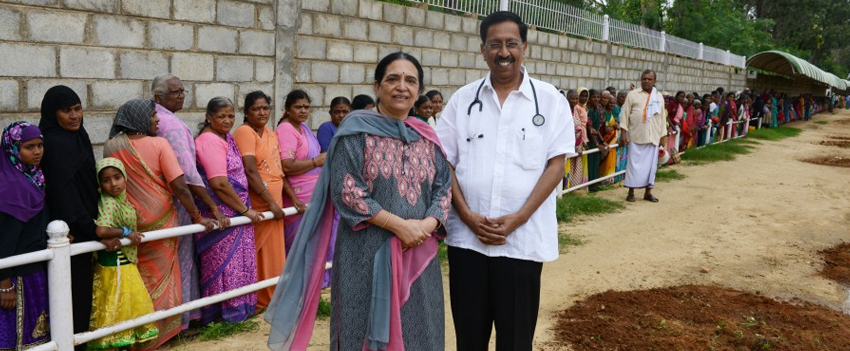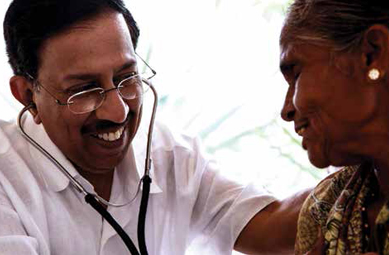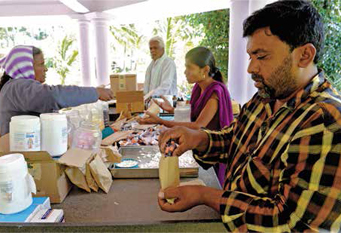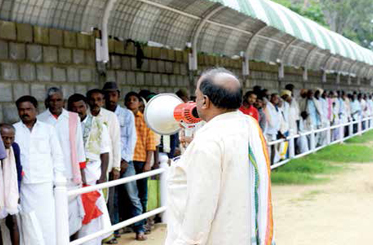Temple of Medicine

The number of patients he treats free of charge at his village clinic every Sunday morning swelled after Dr. B. Ramana Rao was awarded the Padma Shri in 2010 for his contribution to the field of medicine. His family hopes he wins the Padma Bhushan, which will help his work even more.
 Serving the poor
Serving the poorOne day, as a young medical student, Bhogaraju Ramana Rao asked his father why they hadn’t been seeing Jayamma, a young woman they knew. “She is dead!” his father told him. As he grew up, he realised that people like Jayamma often died of simple illnesses. “I could have saved them as a doctor!” he says. Today, he does save many.
In 1973, the year he passed his MBBS from Kasturba Medical College in Manipal, he celebrated his 22nd birthday on August 15 by asking his wife Hema, to drive him to the family’s three-hectare farm plot at T Begur village, 35 km away. There, he set up a borrowed folding table, chairs and umbrella they had taken in the back of their small car, and sent out word: “The doctor is here.”
A few villagers turned up, mainly out of curiosity, to tell him about their ailments. He treated them but didn’t ask for a fee. Word of this spread and a few more patients came the following week. Having opened his village clinic on a Wednesday, he then changed it to a Sunday ritual. Over the past 46 years, Dr Ramana Rao has given free treatment to nearly two million poor patients in rural areas in and around Bengaluru.
Having gone on after his MBBS to do an MD in Medicine and Cardiology from Bangalore Medical College in 1980, he is a consultant physician and cardiologist at a number of city hospitals and is personal physician to the Who’s Who of Bengaluru-from the Chief Minister of Karnataka and most of his cabinet colleagues to top businessmen. He has a private clinic in a posh area of the city. But that is only from Monday to Saturday morning. After lunch, he goes to the farm, which is now a comfortable farmhouse. To relax after the week’s strain? No! To make sure that everything is organised for Sunday, when he spends more than half the day seeing patients who have come by bullock cart, bus or auto-rickshaw, even walking from over 350 villages, as far as 150 km away from his clinic.
“The combination of poverty, illness and old age is deadly. We need primary health care because 99.9 per cent of all illnesses are simple.” The combination of poverty, illness and old age is a ‘deadly’ one, says the man who has been dealing with it for so long. And what’s needed to tackle it is primary health care, not open-heart surgery. And that is at a much later stage, which often doesn’t come if the ‘simple’ illness is detected and treated at the beginning.
Soon after he began to practice, Dr Ramana Rao recalls, an old man came to his clinic and touched his feet with the tearful plea, “Doctor, sir, please save my daughter!” He went out with the man and found a bullock cart standing in the street. Lying inside of the cart was a woman in her early twenties, pale and unable to breathe. “She began bleeding badly after she delivered her sixth child just now, and her husband ran away,” the old man explained. The doctor found that her hemoglobin count was dangerously lowas a result of which, fluid had accumulated in her lungs, abdomen, hands and feet: they were all full of water. “I gave her iron tablets and vitamin B. She recovered. We had given six children their mother back!” he says.
That was when he realised how much power a physician has to help and save people.
Soon after he began practice, Dr. Ramana Rao recalls, an old man came to his clinic and touched his feet with the tearful plea, “Doctor, sir, please save my daughter!” He went out with the man and found
 Clinic provides free medicine
Clinic provides free medicineAnother time, he says, a couple of men drove up in a bullock cart and simply said, “Urgent. Come!” He had a waiting room full of patients. “How can I just leave them and go away?” he reasoned. But they were insistent, so he made his excuses to the waiting patients and went with them. “They took me far away, to a hut where I found an old man burning with fever. I touched his leg-it was full of pus,” he says. “These people lived in total poverty but even before I could start treating my patient, he ordered his sons, in a weak voice, to give me some peanuts to eat! How can I ever repay such love and affection?” He had to amputate the diseased leg and needed six bottles of blood. But the man lives, though he has to walk around on crutches: his family has a father.
Every such instance reinforces his strong belief that primary healthcare is the need of the hour. He does his bit but India needs thousands of village clinics like his. And that, he explains, is why he wants more recognition of the work he does: a Padma Bhushan, the Ramon Magsaysay Award, mention in Ripley’s Believe it or Not and the Malayala Manorama Yearbook, a chapter in text books by the NCERT (National Council of Educational Research and Training), and whatever else is possible. Guinness World Records, he says, won’t recognise his achievement. “My son even went to their headquarters in London but they told him they can include only a record that can be outdone.” His tally of ‘about 1.98 million’ patients, till a couple of years ago, is apparently not one that can ever be surpassed.
And so, Dr Ramana Rao continues to do his own bit. Starting the day with a pooja at the Ganapati temple in his village clinic, he and his helpers dispense medicines to about 1,200 people and conduct various tests, then serve them lunch. The food is what they normally eat at home, rice and sambaar but this rice is of better quality and the sambaar has a lot of lentils and vegetables, providing much-needed protein.
Many of his patients have joined the queues -men on one side of the gate, women on the other-at night and waiting patiently for the gates to open at 9 a.m. Those who come early sit on the long benches in the covered area. Late-comers have to stand. But every one of them-man, woman and child is seen by the doctor. He doesn’t even take a coffee break: “How can I, when all these people have been waiting without tea or coffee-sometimes even water?” he asks simply.
Dr Ramana Rao’s assistants go along the queues, giving every child a box of deworming tablets and vitamin syrup; adults get soap, toothpaste and personal hygiene products as part of the Swasth Bharat initiative. They then let the patients in, in alternating batches of five men and five women with children. As they enter, they file paste a huge blow-up of the late Kannada film star Dr Raj Kumar, whom the people revere and to whom Dr Ramana Rao was a personal physician.
 Clinic staff managing the long queue
Clinic staff managing the long queueAfter the doctor examines each patient-mainly with just a smile, a hand on the affected place and a word of encouragement - he gives him or her a colored plastic token that looks like the ones used to play Ludo. The colour of the token indicates the medicines and treatment needed. Some of the patients come back with questions about the medicine, which he answers patiently.
Many move on to get their blood pressure or sugar level checked, receive an injection or for those with asthma, have a nebuliser session. Besides asthma, common complaints are arthritis, osteoporosis, backache, cough, joint pain and infections caused by lack of hygiene. The latest addition is a set of six dental chairs, set up by Dr Srivats Bharadwaj’s Vatsalya Dental, at which dedicated dentists provide every type of oral care -from simple tooth extraction and root canal surgery to the highly specialised maxillofacial surgery.
At the last stop after medicine and tests or injections, the eating area, each of them picks up a plate from a collection in a wire basket, washes it, along with their hands, with soap and water. After eating, they go through the washing process again.
“I never get tired of doing this!” Dr Ramana Rao says. “I have always viewed it as a prayer. The country needs more such clinics, which are like temples. We are here for everyone-a boy with meningitis, people of all ages, castes and religions.”
After the Padma Shri, he was invited to meet Prince Charles when he was in Kochi. The successor to the British throne asked the doctor for his views on rural health delivery so that they could adopt the village clinic model in England. Many medical colleges also invited him to be the chief guest and deliver motivational talks. “After every engagement, there are a lot of youngsters who are keen to serve, and ask me how they should go about it. There is no need to persuade them, only to create awareness!” he adds.
What keeps him going, at age 68? “My parents, B.S. Rama Rao who was an engineer and B.S. Shakuntala, used to write to me every week when I was studying, telling me that I should serve the rural poor,” he explains. “They told me they had planted me as a banyan tree.” His two sons Charit Bhograj and Abhijit Bhograj, both doctors themselves with additional MD and DM qualifications in cardiology and endocrinology also help at the Village Clinic, as do their wives Shantini, a dermatologist, and Jahnavi, a clinical dietician. The banyan continues to grow.